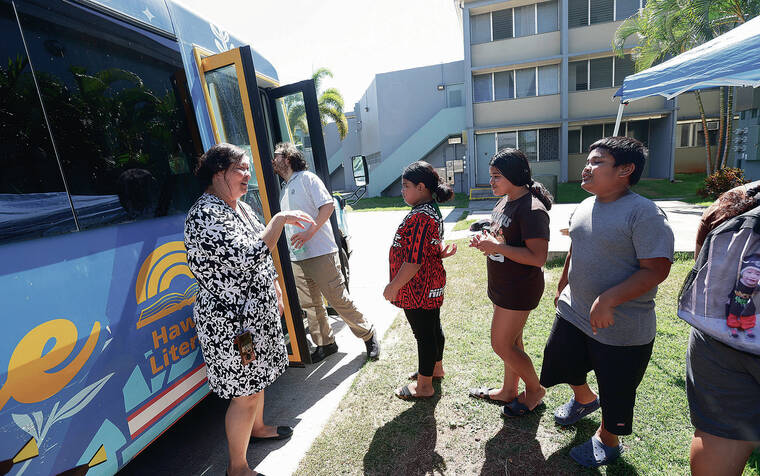Education
Hawaii Faces Literacy Crisis Despite Historic Achievements

Hawaii’s historical reputation as a highly literate society during the 19th century sharply contrasts with the current literacy challenges facing its residents. Today, tens of thousands of adults in the state struggle with basic reading and writing skills necessary for effective participation in family, work, and civic life. Without urgent and coordinated investment, advocates warn that low literacy rates will continue to hinder Hawaii’s economy, burden health systems, and perpetuate intergenerational poverty.
Jill Takasaki Canfield, executive director of Hawaii Literacy, highlighted that while the state performs better than the national average of 22%, approximately 17% of adults in Hawaii still face significant challenges with basic reading skills. In some communities, this figure rises to 25%. Takasaki Canfield explained that many adults read at a third-grade level or lower, limiting their ability to manage essential daily tasks such as filling out forms, completing job applications, or assisting their children with homework.
Data from the U.S. Program for the International Assessment of Adult Competencies (PIAAC) mirrors these state-level estimates, indicating that Hawaii is below the national average for adults with the lowest proficiency levels. Nationally, ProLiteracy reports that around 59 million U.S. adults live with very low literacy skills, struggling with everyday tasks without assistance.
Community Needs and Local Initiatives
Community leaders and service providers assert that in many low-income neighborhoods and immigrant communities, the demand for literacy support far exceeds statewide averages. Pua‘Ena Burgess, who manages Hawaii Literacy’s bookmobile outreach, emphasized the hyperlocal needs observed during their visits. The team typically visits nine to twelve sites each month, serving approximately 8,000 children and adults annually.
From July 2024 to July 2025, the bookmobile made 7,656 visits, distributed 8,689 books, and conducted 1,427 literacy activities or kits. Burgess and her colleagues believe these figures represent just a fraction of the unmet demand in the community. Antoinette Anoc, a longtime Kukui Gardens resident, brings her son, Dominic, to the bookmobile every Wednesday. For her, these visits represent more than just access to books; they foster community trust in educational resources and provide constructive activities for children, helping to reduce youth violence.
On one visit, 37 children, ranging from pre-K to fifth grade, participated in bookmobile activities stocked entirely with donated books. Burgess noted that while popular titles are frequently requested, the program often faces issues with cost and availability, leading to understocked resources.
The Economic Implications of Low Literacy
The implications of low literacy extend beyond education and deeply impact Hawaii’s economy. Brandon Kurisu, a board leader and workforce advocate, emphasized that low literacy is a critical barrier to workforce participation. Adults with the lowest literacy skills are twice as likely to be unemployed, and those who do work earn significantly less than their literate peers. This not only shrinks the talent pool for vital industries like healthcare and tourism but also exacerbates intergenerational gaps, as children of low-literacy parents often start school at a disadvantage.
While Hawaii lacks comprehensive and recent data linking reading levels to earnings, studies indicate significant economic consequences for those unable to access training or higher-paying jobs. A University of Hawaii Economic Research Organization analysis of the Good Jobs Hawaii program found that participants who completed training saw an average real quarterly wage increase of approximately $1,800, or about $7,200 annually, illustrating the economic benefits of literacy.
Moreover, Hawaii Literacy reports that about 70% of adults with the lowest literacy skills are unemployed, and those who do work earn just 44% of what their literate counterparts make, leading to a lifetime earnings loss exceeding $800,000. Research indicates that education and reading ability are among the strongest predictors of future income, with approximately 90% of individuals who struggle with reading comprehension likely to require state assistance at some point.
Innovative Approaches and Ongoing Challenges
Hawaii Literacy and its community partners employ various strategies to address these challenges, including one-on-one adult tutoring, family literacy libraries, and English language learning classes. They also offer digital literacy instruction and connect adult learners to job training and workforce partners.
Throughout its history, Hawaii Literacy has served roughly 40,000 adults and youth through its programs. Takasaki Canfield noted that their evaluation focuses on tracking skill gains, retention, and the quality of services delivered, showing strong progress in both literacy development and workforce readiness. The bookmobile, in particular, serves as an initial point of contact with literacy resources for many families.
Despite these successes, the organization faces challenges related to funding uncertainty, staffing shortages, and limited capacity to measure outcomes across all programs. Takasaki Canfield expressed concerns that cuts in funding mean they can only track deeper outcomes at select sites, limiting their ability to assess the impact across the entire state.
Business engagement in workplace literacy has seen growth, but advocates argue that it must expand further. Kurisu noted examples from both national and local levels where employers investing in on-the-job literacy see measurable returns, including reduced turnover and increased productivity.
Hawaii’s private sector, heavily reliant on a skilled workforce for industries such as healthcare and clean energy, has a vested interest in supporting literacy initiatives. Kurisu emphasized that improving literacy is not just a social responsibility but an economic imperative. Every dollar invested in literacy is a dollar invested in Hawaii’s future workforce and competitiveness.
In conclusion, as Hawaii grapples with its literacy crisis, the intersection of education, economic opportunity, and community engagement becomes increasingly vital. Addressing these challenges will require collaborative efforts from both local organizations and the business sector to ensure that all residents have the skills necessary to thrive.
-

 Technology5 months ago
Technology5 months agoDiscover the Top 10 Calorie Counting Apps of 2025
-

 Health3 months ago
Health3 months agoBella Hadid Shares Health Update After Treatment for Lyme Disease
-

 Health3 months ago
Health3 months agoErin Bates Shares Recovery Update Following Sepsis Complications
-

 Technology4 months ago
Technology4 months agoDiscover How to Reverse Image Search Using ChatGPT Effortlessly
-

 Technology1 month ago
Technology1 month agoDiscover 2025’s Top GPUs for Exceptional 4K Gaming Performance
-

 Technology3 months ago
Technology3 months agoElectric Moto Influencer Surronster Arrested in Tijuana
-

 Technology5 months ago
Technology5 months agoMeta Initiates $60B AI Data Center Expansion, Starting in Ohio
-

 Technology5 months ago
Technology5 months agoRecovering a Suspended TikTok Account: A Step-by-Step Guide
-

 Health5 months ago
Health5 months agoTested: Rab Firewall Mountain Jacket Survives Harsh Conditions
-

 Technology5 days ago
Technology5 days agoOpenAI to Implement Age Verification for ChatGPT by December 2025
-

 Lifestyle5 months ago
Lifestyle5 months agoBelton Family Reunites After Daughter Survives Hill Country Floods
-

 Health3 months ago
Health3 months agoAnalysts Project Stronger Growth for Apple’s iPhone 17 Lineup





















